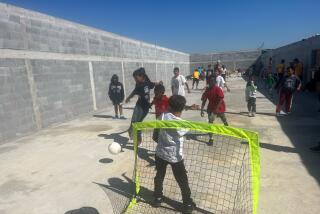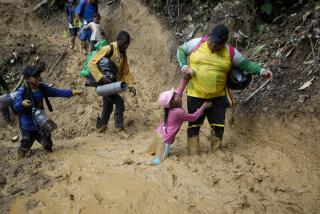Children of the Rails
NEW YORK — As a creative writing teacher in one of this city’s strapped public schools, Stephen O’Connor had a memorable student who, for all her promise, couldn’t escape her family’s poverty or illness. A gifted writer and actor, the teenager missed an audition--and the chance to attend the famed Fiorello H. LaGuardia High School of Music and Art and Performing Arts--because her alcoholic mother needed her help at home.
A few years later, that girl’s story and the plight of her peers were a constant source of inspiration as O’Connor wrote about their 19th-century counterparts.
Then as now, O’Connor said, poor children suffered society’s disdain--so much so that between 1854 and 1929, roughly 250,000 of them were sent away from the city to the country in an early experiment with foster care. Their experience is detailed in O’Connor’s new book, “Orphan Trains: The Story of Charles Loring Brace and the Children He Saved and Failed” (Houghton Mifflin), a compassionate account that, like all good histories, is full of sobering lessons.
“In this era when all politicians claim to be pro-family and when they claim they want to protect the innocence of children, the truth of the matter is we don’t really care very much about children,” O’Connor said recently. “Anyone who works with a child is underpaid .... What does that say about how much we value these people?”
Another lesson comes from the well-intentioned methods of Charles Loring Brace, the idealistic young minister who founded the Children’s Aid Society in 1853. Brace didn’t actively seek converts to his Protestant beliefs, yet he was a virulent anti-Catholic, O’Connor’s research showed.
His charges--most of them born to Irish, German and Italian parents--became Protestant by default within their mostly Protestant foster homes. That in itself, O’Connor said, might serve as a warning about hidden agendas at a time when conservatives hope to restore religious charities’ control of many social services.
In an interview at his apartment, a labyrinth of books and folk art near Columbia University, O’Connor discussed his topic with zeal. An animated man with chin-length silver hair and chiseled features, he sometimes had to shout above the noise from Broadway to make his points. “I care a lot about the hardships of poor children and the injustices in the way that society treats poor children,” he said. “This book clearly fit into that and allowed me to look into the past and see some of the history.”
Nineteenth-century New York, with its booming port, rising capitalism and waves of immigrants, was as torn between rich and poor as it is today. Vagrant children packed the city’s streets, working as beggars, shoe shiners, flower sellers and prostitutes. Prosperous citizens were repulsed and begged authorities to get them off the streets.
Many children wound up in adult prisons or almshouses--until a charity called the Children’s Aid Society reworked the notion of indentured labor and put them on trains bound for rural households in the Midwest and West.
Most of the train riders were referred to the organization’s so-called emigration plan by orphanages, hospitals and the original Newsboys’ Lodging House, which was a sort of boarding house and Christian school for homeless boys hawking newspapers. Almost all the children and teenagers came from New York’s “poorest, most crowded and most dangerous neighborhood,” as O’Connor described it, a section of Lower Manhattan known as Five Points.
Taverns and bordellos were the only thriving businesses in the area, which was controlled by thugs and thieves. An old brewery, “the area’s most infamous building,” was supposedly “the site of more murders than any other structure in the city.”
O’Connor’s chapter devoted to the first train riders, a group of 37 boys and girls bound for Dowagiac, Mich., illustrates the emotional horrors of their removal from the city and the breathtaking promise of the countryside. “As we whirled through orchards loaded with large red apples,” an escort reported back to New York, “their enthusiasm rose to the highest pitch. It was difficult to keep them within doors. Arms stretched out, hats swinging, eyes swimming, mouths watering, and all screaming, ‘Oh! Oh! Just look at ‘em Mister, be they any sich in Michigan? Then I’m for that place. Three cheers for Michigan!”’
Adoption was the agency’s professed goal and many of the children were indeed in desperate need of loving families. But as O’Connor’s book makes painfully clear, train tickets cost a lot less than room and board--a one-time payment of about $10 each compared to the $85 a year it cost at the time to maintain a poor-house resident. Moreover, not all the society’s charges were literal orphans. Many had at least one living parent too sick or too poor to care for them. Some were runaways or illegitimate. Others had simply become separated from relatives.
“We were living at Philadelphia, and I was a very little boy,” begins the story of one orphan train rider named John Jackson, who found his way to the Children’s Aid Society in New York in 1859 and was quickly dubbed “the runaway white-slave boy.”
“I heard the soldiers one day, as they were a goin’ through Philadelphia with their music and drums. So I followed them along, and at night I couldn’t find my way back home to mother. I was so sick from crying and so tired from walking that I lay down in Market Street and fell asleep.”
Young Jackson was picked up by local police, brought to a poorhouse, and sent into indentured slavery on a Delaware farm just days before his mother came to the poorhouse to retrieve him. After a short life of running from one grueling job to the next, he joined the Union Army and, at the age of 18, died in the battle of Shiloh.
As disturbing as Jackson’s story is, it was detailed, first-hand sagas like his that drew O’Connor into the project. Passed on by a friend who had just finished work on an orphan trains documentary, the handwritten accounts immediately reminded O’Connor of his New York students.
“They were just great stories and the Children’s Aid Society gave me access to its archives, which contained 105,000 cases of orphan train riders,” O’Connor said. (The agency, with a budget of about $21 million, still exists as the 15th largest of New York’s 60 child welfare contractors.)
O’Connor also identified with Brace. The son of a Connecticut teacher, Brace had traveled widely through Europe, met revolutionaries and held progressive views. He passionately believed in treating poor children as individuals and victims of circumstance, not parts of some criminal element. He also recognized the importance of educating them.
“I used myself as I was thinking about Brace because I know what it was like to go and work with poor kids,” said O’Connor, whose paternal grandfather was an Irish-born union organizer.
“I knew not only how you can be moved and feel compelled to do something--to think ‘I must, I must, I must help these kids!’--but that you’d also be frustrated and you’d be furious that they don’t appreciate the things you’d try to do for them.”
But just as O’Connor felt constrained by insufficient public school funding and his students’ myriad personal problems, Brace was also a prisoner of his time, a harsh era when children were viewed as miniature adults expected to earn their keep. As a result, most orphan train riders wound up as farmhands and servants for families who sometimes adopted and schooled them but very often did not.
The orphans became a hapless part of the great migration westward, helping to build farms and towns along the railroads. Two train riders who became friends on their trip, John Brady and Andrew Burke, became governors of Alaska and North Dakota, respectively.
“As the frontier moved westward, there was always a need for people to work. So Brace was counting on that to help these kids,” O’Connor said. “And, indeed, one of the things that really ended the orphan trains was the closing off of the West. The frontier was officially closed in 1898, and as the Western states developed poor populations of their own--their own vagrant children and so forth--they didn’t want to take any more of the East’s.”
The most intriguing thing about Brace, for O’Connor, was how deeply conflicted his crusade became as it struggled to survive. (The Children’s Aid Society foundered in debt, barely able to manage on private donations, until it finally received state funding.) Brace clearly cared about poor children, yet his charity had no meaningful system of monitoring their welfare and he all but ignored reports of abuse. He wanted to improve their lives, yet, as O’Connor put it, he “turned his back on the kids’ families and neighborhoods.”
O’Connor is a self-proclaimed atheist, yet in his writings and personal life seems as preoccupied with morals as any theologian. At home, he equally shares housekeeping and responsibility for his two children, ages 9 and 17. In “Orphan Trains,” he said, “I was really interested in how people take moral action and I wanted to trace the arc of that whole action, to show its origins and consequences. They were complex, not everything was admirable or laudable.”
Man’s flawed impulse to do good is the common thread in his collection of short stories, “Rescue,” and it’s the theme of the novel he is currently writing, about a man who gets away with murder and his subsequent years. It is also the guiding force of his teaching memoir, “Will My Name Be Shouted Out?,” about reaching inner-city students through the power of writing. The book recounts his eight years at a middle school on Manhattan’s Upper West Side and the struggles of his students, including the girl he calls Xia who had so much talent.
“I was indeed idealistic and I was horrified and I made a connection,” O’Connor said of his teaching experience and the book it inspired. “But the real point I want to make is that no one teacher, no perfect school, can really give these children everything they need because the problems are so much larger than any individual, or any individual institution, can hope to address.”
In his memoir, O’Connor said, he wanted to show what life is like for poor children in the city and why it’s so hard for them to get an education, including how inadequately their schools are funded. In “Orphan Trains,” he said, he found himself doing the same thing.
“Writing about it made me feel as though I was doing good. I couldn’t help those particular kids who were long dead, but by writing about this sort of situation in a small way might help people to understand the situation now.”
More to Read
Sign up for our Book Club newsletter
Get the latest news, events and more from the Los Angeles Times Book Club, and help us get L.A. reading and talking.
You may occasionally receive promotional content from the Los Angeles Times.








